Product Images Finasteride
View Photos of Packaging, Labels & Appearance
- Figure 1 Symptom Score in a Long-Term Efficacy and Safety Study - finasteride fig1
- Figure 2 Percent of Patients Having Surgery for BPH, Including TURP - finasteride fig2
- Figure 4 Prostate Volume in a Long-Term Efficacy and Safety Study - finasteride fig3
- Figure 5 Cumulative Incidence of a 4-Point Rise in AUA Symptom Score by Treatment Group - finasteride fig4
- finasteride-fig5 - finasteride fig5
- finasteride fig6
- chemical structure - finasteride str
Product Label Images
The following 7 images provide visual information about the product associated with Finasteride NDC 65862-149 by Aurobindo Pharma Limited, such as packaging, labeling, and the appearance of the drug itself. This resource could be helpful for medical professionals, pharmacists, and patients seeking to verify medication information and ensure they have the correct product.
Figure 1 Symptom Score in a Long-Term Efficacy and Safety Study - finasteride fig1
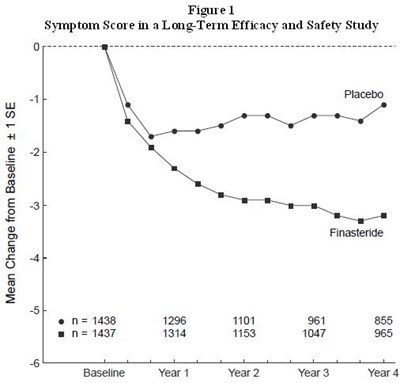
The text appears to be a table showing mean change from baseline + 1 SE, along with a figure indicating symptom score in 2 long term efficacy and safety studies. The table compares the results of a placebo treatment versus a treatment of Finasteride, with baseline and yearly scores over four years. Therefore, it can be inferred that the context of this text is a medical study, likely exploring the effectiveness and safety of Finasteride as a treatment for a particular medical condition.*
Figure 2 Percent of Patients Having Surgery for BPH, Including TURP - finasteride fig2
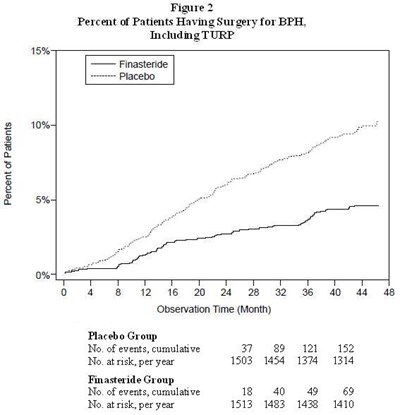
This is a graph named "Percent of Patients Having Surgery for BPH, Including TURP" with observation time in months on the X-axis and percentage of patients on the Y-axis showing the result of a trial where Finasteride was given to patients with BPH and the number of surgeries performed. The graph shows that the Finasteride group had a lower percentage of patients needing surgery for BPH than the placebo group at 15% and 0%, respectively, after 48 months of observation time. The graph also shows additional information in tabular form for the number of events, cumulative events, and number at risk per year for both the placebo and Finasteride groups.*
Figure 4 Prostate Volume in a Long-Term Efficacy and Safety Study - finasteride fig3
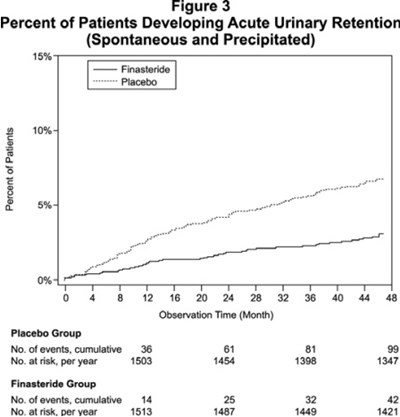
The text is a figure that shows the percentage of patients developing acute urinary retention over time in a clinical trial that compared finasteride to a placebo. The data is presented graphically and includes the number of events and patients at risk at different time points.*
Figure 5 Cumulative Incidence of a 4-Point Rise in AUA Symptom Score by Treatment Group - finasteride fig4
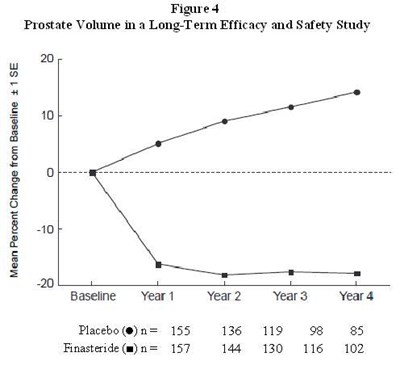
This is a visual representation of the mean percent change from baseline in prostate volume in a long-term study evaluating the efficacy and safety of finasteride compared to placebo over the course of 4 years. The table shows the number of participants for each group and their corresponding prostate volume measurements at baseline and over the duration of the study.*
finasteride-fig5 - finasteride fig5
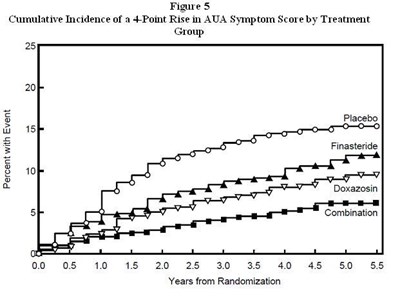
The image shows a graph with the cumulative incidence of a 4-point rise in AUA Symptom Score by treatment group over time (years from randomization). The vertical axis represents the percent with the event, ranging from 0 to 25%. The horizontal axis shows the years from randomization from 0 to approximately 55 years.*
* The product label images have been analyzed using a combination of traditional computing and machine learning techniques. It should be noted that the descriptions provided may not be entirely accurate as they are experimental in nature. Use the information in this page at your own discretion and risk.

